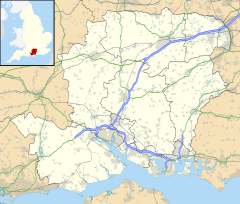Highclere Castle
| Highclere Castle | |
|---|---|
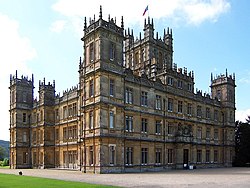 Highclere Castle, front facade | |
| General information | |
| Status | Grade I listed[1] |
| Type | Stately home |
| Architectural style | Jacobethan |
| Location | Highclere, Hampshire, UK |
| Construction started | 1839 |
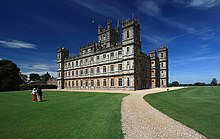
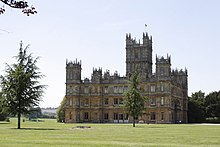
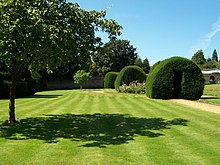
Highclere Castle /ˈhaɪklɪər/ is a country house in the Jacobethan style, with park designed by Capability Brown. The 1,000-acre (400 ha) estate is in Hampshire, England, United Kingdom, about 5 miles (8.0 km) south of Newbury, Berkshire. It is the country seat of the Earl of Carnarvon, a branch of the Anglo-Welsh Herbert family.[2]
Highclere Castle is the main filming location for the British television period drama Downton Abbey.[3]
History
Early years
The castle stands on the site of an earlier house, which was built on the foundations of the medieval palace of the Bishops of Winchester, who owned this estate from the 8th century. The original site was recorded in the Domesday Book. Since 1679, the castle has been home to the Carnarvon family.
In 1692, Robert Sawyer, a lawyer and college friend of Samuel Pepys, bequeathed a mansion at Highclere to his only daughter, Margaret, the first wife of the 8th Earl of Pembroke. Their second son, Robert Sawyer Herbert, inherited Highclere, began its picture collection and created the garden temples. His nephew and heir Henry Herbert was created Baron Porchester and 1st Earl of Carnarvon by King George III.
19th century
The house was then a square, classical mansion, but it was remodelled and largely rebuilt for the third Earl by Sir Charles Barry[3] in 1839–1842, after he had finished building the Houses of Parliament. It is in the Jacobethan style and faced in Bath stone,[3] reflecting the Victorian revival of English architecture of the late 16th century and early 17th century, when Tudor architecture was being challenged by newly arrived Renaissance influences.
During the 19th century there was a huge Renaissance revival movement, of which Sir Charles Barry was a great exponent—Barry described the style of Highclere as "Anglo-Italian".[4] Barry had been inspired to become an architect by the Renaissance architecture of Italy and was very proficient at working in the Renaissance-based style that became known in the 19th century as Italianate architecture. At Highclere, however, he worked in the Jacobethan style, but added to it some of the motifs of the Italianate style. This is particularly noticeable in the towers, which are slimmer and more refined than those of Mentmore Towers, the other great Jacobethan house built in the same era. Barry produced an alternative design in a more purely Italian Renaissance style, which was rejected by Lord Carnarvon.[5] The external walls are decorated with strapwork designs typical of Northern European Renaissance architecture. The Italian Renaissance theme is more evident in the interiors. In the saloon, in an attempt to resemble a medieval English great hall, Barry's assistant Thomas Allom introduced a Gothic influence evident in the points rather than curves of the arches, and the mock-hammerbeam roof.[6]
Although the exterior of the north, east and south sides were completed before the 3rd Earl died in 1849 and Sir Charles Barry died in 1860, the interior and the west wing (designated as servants' quarters) were far from complete. The 4th Earl turned to the architect Thomas Allom, who had worked with Barry, to supervise work on the interior of the Castle, which was completed in 1878.
The 1st Earl rebuilt his park according to a design by Capability Brown in 1774–1777, relocating the village in the process—the remains of the church of 1689 are at the south-west corner of the castle. The famous 18th century seed collector Bishop Stephen Pococke was a friend and brought Lebanon Cedar seeds from a trip to Lebanon.
20th century
This section needs expansion. You can help by adding to it. (February 2013) |
The castle became home to Egyptian artifacts after the 5th Earl, an enthusiastic amateur Egyptologist, sponsored the excavation of nobles' tombs in Deir el-Bahari (Thebes) in 1907.[7] He later accompanied archaeologist Howard Carter during the discovery of the tomb of Tutankhamun in 1922.
In 1969, Henry Herbert, 7th Earl of Carnarvon, became racing manager to Queen Elizabeth II.[8] The 7th Earl was "great friends" with the Queen; she was a "frequent visitor until his death in 2001".[9]
21st century
By 2009, the castle was in dire need of major repair, with only the ground and first floors remaining usable.[9] Water damage had caused stonework to crumble and ceilings to collapse; at least 50 rooms were uninhabitable.[9] The 8th Earl and his family were living in a "modest cottage in the grounds"; he said his ancestors were responsible for the castle's long term problems."[9] As of 2009, repairs needed for the entire estate were estimated to cost around £12 million, £1.8 million of which was urgently needed for just the castle.[9]
Details
There are various follies and eye-catchers on the estate. To the east of the house is the Temple, a strange structure erected before 1743 with Corinthian columns from Devonshire House in Piccadilly. "Heaven's Gate" is an eye-catcher about 18 m high on Sidown Hill, built in 1731 from a design, it is thought, by the 9th Earl of Pembroke. It fell shortly afterwards. The event was witnessed by Rev. J Milles, who recorded that "we had not been there above half an hour before we saw it cleave from ye foundations and it fell with such a noise yet was heard at three or four miles (5 or 6 km) distant."
The hybrid holly Ilex x altaclerensis (Highclere holly) was developed here in about 1835 by hybridising the Madeiran Ilex perado (grown in a greenhouse) with the local native Ilex aquifolium.
Use as location
- 1982: It was seen as the home of a wealthy Englishman that Mr. Fortescue visited seeking money in the 1982 film starring Michael Palin, The Missionary. The castle exterior appears about 19 minutes and 30 seconds into the film.[citation needed]
- 1987: Shots from both the interior and exterior were used as the imposing Mistlethwaite Manor in the Hallmark Hall of Fame's 1987 version of The Secret Garden.[10]
- 1990–1993: Totleigh Towers, in the TV version of Jeeves and Wooster, was represented by Highclere Castle.
- 1991: The exterior appeared as Lord Graves's house in the film King Ralph.[11]
- 1992: It was portrayed as the home of the 23rd Earl of Leete in Jim Broadbent and Mike Leigh's 1992 mock biopic A Sense of History.[12]
- 1999: The saloon provided a main interior location for Stanley Kubrick's final film, Eyes Wide Shut.[13]
- 2001: The exterior appeared as the Raichand mansion in the Bollywood blockbuster Kabhi Khushi Kabhie Gham.
- 2002: The saloon appeared in the film The Four Feathers starring Heath Ledger.[14]
- 2006: John Legend's 2006 music video for "Heaven Only Knows" features the castle.
- 2010–present: It is the main setting for the British television period drama Downton Abbey, as a result of which The Tatler referred to the area around Highclere as "Downtonia".[15]
See also
References
- ^ "Highclere Castle, Highclere". British Listed Buildings. Retrieved 5 October 2011.
- ^ Highclere Castle
- ^ a b c Dickson, Elizabeth (January/February 1979). "Historic Houses: The Splendors of Highclere Castle". Architectural Digest. Retrieved January 2, 2013.
{{cite news}}: Check date values in:|date=(help) - ^ Henry Russell Hitchcock (1958) Architecture: Nineteenth and Twentieth Centuries (Pelican History of Art), London, Peguin Books, p.73
- ^ Roger Dixon and Stefan Muthesius. Victorian Architecture. Thames and Hudson 1978, pp.39–40
- ^ "Highclere Castle, Earl of Carnarvon, Egyptian antiquities, State Rooms". Highclerecastle.co.uk. Retrieved 2012-09-30.
- ^ A letter from Gaston Maspero dated 14 October 1907, contained in the archives of Maspero in the library of the Institut de France says, "You have been kind enough to say to me that you could find a man who knows Egyptology to survey my works. Have you thought to anybody? I will leave the question of payment in your hands but I think I would prefer a compatriot" (Manuscripts 4009, folios 292–293). On 16 January 1909, Carter wrote to Maspero, "Just a word to tell you that Lord Carnarvon has accepted my conditions. He will be there (in Egypt) from 12 February to 20 March. I have to thank you again..." (Manuscripts 4009, folio 527) - from Elisabeth David.
- ^ Charles Mosley, editor, Burke's Peerage, Baronetage & Knightage, 107th edition, 3 volumes (Wilmington, Delaware, U.S.A.: Burke's Peerage (Genealogical Books) Ltd, 2003), volume 1, p. 698
- ^ a b c d e Harris, Paul (5 August 2009). "Can Highclere Castle be saved? Historic home is verging on ruin as Lord Carnarvon reveals £12m repair bill". Daily Mail. Retrieved 2013-02-18.
- ^ Williams, George (29 November 1987). "Filming 'Secret Garden' was a nightmare". McClatchy News Service..
- ^ King Ralph UK filming locations.
- ^ The programme can be seen on YouTube, titled "A Sense of History (1992)".
- ^ Mcdermott, Kerry (30 March 2013). "How Stanley Kubrick transformed genteel Highclere mansion into Hollywood hothouse because of his fear of flying". The Mail Online. Retrieved 1 April 2013..
- ^ The Four Feathers UK filming locations.
- ^ The Tatler, January 2011.
External links
- Official website
- Highclere Castle entry from The DiCamillo Companion to British & Irish Country Houses
- Highclere Castle on The Internet Movie Database
- "Take a guided tour around the real Downton Abbey". The Telegraph. 7 October 2011. Retrieved February 16, 2012.

